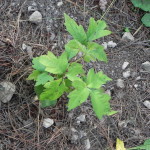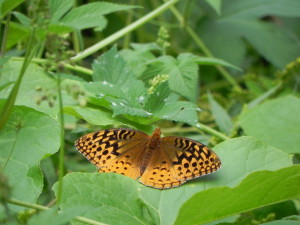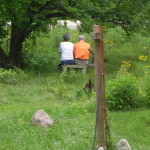by Winding Pathways | Aug 25, 2014 | Labyrinths, Reflections/Profiles, Wonderment
Hot. Humid. Still. Not exactly an optimal day or time to walk a labyrinth. Necessary.
For weeks I have known that the labyrinth needed tending. The blooming grasses have shot up toward the sun and lodged over. Some completely block the path. Searching for the light, others have crowded into and narrowed the path. Deer have ripped off plant tops. The bird bath is dry. One area has too much sun. Plants are overly exuberant. Another has too much shade. Plants are withered. Creeping Charlie has overwhelmed the stepping stones. Too much and too little of everything. Everything feels out of balance.
Pausing, I begin to notice the beauty. My attitude shifts. Butterflies and other pollinators busily work the flowers. The occasional, slight breeze passes grass pollens plant to plant. The lyrical chatter of the goldfinches undulating across the yard brightens the day. In the shade a random breeze cools my skin. Suddenly the path widens – grace of my imperfect planning. Black Eyed Susans and nodding onions ready to harvest. Tiny purple blooms peek out from the robust prairie forbs. The magnolia pods are set for next spring.
As I notice the plants leaning into the light, Universe and I have a conversation. Behaviors are the manifestation of the negative energies that have persisted in the building and congregation. “What is my role?”
“A labyrinth walk for healing.”
Then, the counter thought: “Those who choose to heal will be here. Those who choose not to heal will not.” (And those who have been deeply wounded, will need to decide.) So, preaching to the choir. But it doesn’t invalidate the experience.
A Pema Chodron quote keeps coming to mind. “Our true nature is like a precious jewel: although it may be temporarily buried in mud, it remains completely brilliant and unaffected. We simply have to uncover it.”
“Simply.” That is the rub. Robyn M-K and Maria K’s service Sunday spoke to “covenant.” From the French covenir and earlier – Latin – covenire – “come together.” About “relationship.” What kind of relationships do we wish to have and in what ways can we move most successfully in these directions of “right relationships”? How do we relate to those who are hurt – even by their own actions? And those on the side who receive the hurt.
Unanswered.
On the way out I re-entered the heat and sun, spotting blooms that I missed on the way in. Joyful. I pushed aside the lodged grasses, intent on my mission. Blocks yielded easily.
Now what. Tranquility isn’t always easy to sort through.
by Winding Pathways | Aug 19, 2014 | (Sub)Urban Homesteading, Foraging, Nature, Trees/Shrubs
Every fall zillions of acorns cascade down into lawns, tumble roll off roofs, and pile up in American driveways. Raking them up is a dreaded autumn chore. Anyone who collects and disposes of acorns is tossing away delicious food.
Too many people believe these big oak nuts are toxic, perhaps because they are bitter when eaten raw. For deer, woodchucks, squirrels blue jays and a host of other wild creatures, acorns are a bonanza of nutritious food so important that a heavy acorn crop means a winter of good health while a sparse one spells starvation.
Native Americans enthusiastically collected, processed, stored and ate acorns. And they are a common food in some European cultures. A great acorn benefit in the days before refrigeration was the ability to store them indefinitely, providing food if crops failed or game was scarce. Far too many modern people don’t realize that acorns are delicious if properly prepared.
Dozens of oak species live around the world. In North America much of the eastern hardwood forest is dominated by oaks with several scattered scrubby species in the southwest and many larger ones near the Pacific coast. Even on the Great Plains and in the Rocky Mountains, where native oaks either don’t occur naturally or are uncommon, they have been planted in nearly every town and city.
Although there are many oak species all fall within one of two categories:
White Oak Group: The leaves of these oaks have rounded lobes and generally the trees produce an abundant acorn crop irregularly. Often a few falls go by with a sparse crop nuts. Then during a banner year, millions of acorns carpet a forest floor. Almost every year there will be a tree or two here and there with a heavy crop while others nearby are barren. Common white oak group species are the bur, white, and chestnut oaks. Acorns in this group have the lowest tannin content, are usually large and require the least processing. If white oaks live in your area these are the acorns to gather.
Black (or Red) Oak Group: These trees have leaves with lobes that end in points. The acorns are usually smaller than those in the white oak group but normally trees in this group produce a more reliable crop. Typical species are pin, black and red oaks.
Nearly all oaks produce acorns that can be processed for food, but because those in the white oak group produce the largest nuts with lowest tannin content, we exclusively process acorns gleaned from under white and bur oak trees. We leave the black oak group acorns for the squirrels.
Tip: When you’ve found a prolific oak just starting to drop its nuts carefully slice an acorn or two in half with a paring or pocket knife and use the point of the knife to pry the kernel out of its husk. Taste it. If it’s only modestly bitter you’ve found great acorns. If it’s very bitter seek out another tree. Although white and bur oaks usually have the sweetest acorns the tannin content varies from tree to tree, so gathering the sweetest acorns reduces later work removing this bitter substance. A white or bur oak tree producing sweet acorns may be growing next to a tree of the same species with bitter kernels. Gather the sweet ones.
HOW TO PROCESS ACORNS INTO DELICIOUS FOOD

Making delicious acorn muffins with school children.
Here is how we convert acorns into delicious food:
• Collect acorns as soon as they fall from the tree. Normally oaks begin dropping nuts in late August. September is the prime gathering month. Usually the easiest way to gather a bunch of acorns is to find a prolific white or bur oak growing over a parking lot or driveway. It’s easier sweeping up a few gallons of acorns from pavement than picking them out of the forest floor or lawn. Various insects realize that acorns are good food and quickly bore into fallen nuts. So, beat the squirrels and bugs to the acorns, pick a few gallons and bring them home. Collect only perfect acorns lacking cracks, sprouts or holes.
• Put newly collected acorns in large zip lock bags and freeze them. Freezing kills insects that may be hiding in the acorns and prevents sprouting and mold. Processing acorns is fairly tedious and time consuming. We are usually busy during acorn season and have more processing time when winter hits. So, we store our acorns in the freezer until later. Processing acorns while sitting next to a cozy January woodstove and listening to music is a pleasant winter activity. But, if you want to immediately process acorns after collecting them freezing is optional.
• Put a few gallons of fresh or frozen acorns in a large pot, like a canning pot, nearly fill it with water, and boil for 15 or 20 minutes. Boiling does two things. It softens the husks, making for easier shelling and it removes some tannin. As tannin leaches out of the nuts the water will darken. Let the boiled acorns cool down and drain them. Collect your tools. You’ll need a sharp paring knife, a cutting board, two pots and a good light source.
• Remove the kernels by cutting each acorn in half lengthwise. It should be easy to cut through the water softened husk. Use the point of the knife to pop the kernels into one bowl and the husks in the other. We compost husks They also make good mulch.
• Pour the kernels into a large pot of boiling water and slowly boil them for about ten minutes. As tannins leach out of the nuts the water will darken. While the nuts are boiling bring another pot of water to a boil. Drain the nuts from the first pot and put the kernels into the second pot of clean boiling water. If your acorns were sweet only two or three boilings will remove the tannin. When boiling water darkens only slightly you know you’ve leached out most of the tannin and there will be little bitterness left. Red or pin oak acorns could take five or six boilings to remove tannin.
• Once the tannin is gone thoroughly drain the acorns in a large colander.
• Spread the drained water-softened acorn kernels on a cookie sheet one layer deep. Dry them in an oven on low heat, stirring occasionally. The object is to dry them, not cook them. This part takes a couple of hours. When dry, the kernels will be rock hard.
Once they are completely dry, hard and cooled the acorns can either be placed in airtight jars or other storage containers or immediately ground into flour. Dried acorns will keep for years and unground kernels can be added to stews much like you might add dried beans. This is how Native Americans commonly used them.
Or
• Place the hard dry kernels in a heavy duty blender or hand or electric mill designed for grinding grain. Grind them to the texture of fine flour. Store in an airtight container. Sift the flour to separate out harder kernels. These you can store separately and add to soups where they soften and add a rich earthy flavor to the broth.
We use acorn kernels in soups and the flour in recipes such as Boston Steamed Brown Bread, cookies and muffins. Here are two of our favorite acorn recipes:
Acorn Cookies from the Kitchen of Yvonne Fellows
½ Cup cooking oil ½ tsp. almond extract
½ Cup honey ¼ Cup acorn flour
2 beaten eggs 1 ¾ Cup regular flour (if whole wheat increase the liquid)
Pre-heat oven to 375 degrees. Blend oil and honey. Beat eggs into the mix. Add almond extract then the wheat and acorn flours. Batter should be cookie dough consistency so add more flour if needed. Drop by spoons full onto greased baking sheet. Bake 15 minutes at 375 degrees.
Acorn Muffins adapted from a recipe by Yvonne Fellows
One beaten egg ¼ Cup sugar
One Cup milk 1 ¾ Cups flour
(mix of whole wheat and white or pastry)
2 TBSP vegetable oil ¼ Cup Acorn sifted flour
½ Cup molasses or honey
(I use a combination) 2 tsp baking powder
1tsp vanilla ½ baking soda
Pre-heat oven to 375 degrees. Grease muffin tins or use baking cups. Mix wet and dry ingredients in separate bowls. Blend wet and dry ingredients together until just moist. Some small lumps are OK. Fill muffin tins or baking cups 2/3 full. Bake at 375 degrees for 20 – 25 minutes. Tops of muffins should spring back when done. To prevent dryness, avoid over baking. Serve warm with honey and butter.
by Winding Pathways | Aug 19, 2014 | Flowers/Grasses, Nature

These beneficial wildlife plants are the bane of unsuspecting gardeners.
Few plants cause as much human misery as poison ivy. Direct contact with the allergenic oil on its leaves or in its roots or stems can cause itchy welts in people.
Poison ivy is as tricky as it is common. Most outdoor people know to avoid it when it’s growing rapidly in spring but forget about it the rest of the year. We’ve gotten a poison ivy rash in nearly every month and most commonly get a good case in late spring when we’re working in the yard and garden. The plant is sappy then and when we’ve inadvertently pulled the roots out of the ground without wearing gloves we’ve gotten rashes. But late summer into fall are also prime times to get poison ivy rash. Birds eat the seeds which they drop in excrement and the new plants take hold in summer’s lushness. Gardeners encounter the new plants during deep-season weeding or fall “tuck-in” time.
Poison ivy is common in urban and rural areas. It is highly adaptable, preferring light shade, but also thriving in full sun and dense shade. Usually it hugs the ground, but it can grow to a shrub six feet tall or a vine that climbs to the top of trees. It likes to hide inside the greenery of urban hedges. Poison ivy usually has three leaves and is often confused with five-leafed Virginia creeper.
Humans must come in physical contact with the plant or its oil (urushiol) to end up itching. Inhaling smoke laced with poison ivy is asking for trouble. People generally contract poison ivy from tools, pets, farm animals and clothes that have contacted the plant. Any season is game. The Centers for Disease Control and Prevention has an excellent page on range of the plant and its cousin poison oak as well as poison sumac, symptoms, prevention, and care of tools that have been used in extricating poison ivy. Avoiding contact is the best way to prevent a rash. If bare skin comes in contact with the plant immediately wash the area with plenty of soap and warm water.
Despite the misery it causes humans, poison ivy is valuable to wildlife. Deer and cottontails readily eat it, especially in the winter. Birds devour the seeds helping to spread it around in their droppings. Birds like to perch on small end branches of trees so, we’ve learned to look up and assess the likelihood of contacting poison ivy shoots before plunging into a weedy flower bed.
The plant has another merit. Its leaves are one of the first to turn color in early fall, often to a brilliant red. Spot a patch of bright red leaves close to the ground in September and chances are they are either poison ivy or nonpoisonous smooth sumac.
by Winding Pathways | Aug 15, 2014 | Nature, Trees/Shrubs
We are lucky to have four species of oak trees on our property. Huge white oaks hug the north end with a few red oaks scattered between them. Two medium sized black oaks live close to the house and a young bur oak is just beginning to cast shade south of the house.
Millions of other homeowners are also fortunate to have oaks shading their property. They are one of the most widespread trees, and are beautiful, sturdy, valued by wildlife and long lived. A white oak could shade the ground and feed squirrels for up to 400 years. Some species, like red oaks, grow relatively quickly and tolerate moderate shade while most other oaks, like our bur, need full sun and grow slowly.
About 600 oak species are found naturally across the northern hemisphere. Approximately 90 species live in the United States. China boasts around 100 species, and Mexico is probably the world leader in oak diversity with at least 160 species. They have been widely planted in temperate regions including many places where they don’t occur naturally.
Oaks are members of the beech family with the genus name Quercus. It’s rather easy to distinguish an oak tree, but determining just what oak species a tree belongs to can be tricky. Many oaks hybridize with similar oak species and a tree may have characteristics of each parent. Sometimes the shape of an oak leaf near the top of a tree may be shaped differently from a counterpart lower down.
Non-showy oaks flower in mid spring about the time leaves appear. Male blooms are slim, drooping and green or tan in color. Each female flower is a solitary spike. People allergic to the wind borne pollen generally suffer in the spring.
Throughout history oak wood has been readily used by people. Even wine corks are made from the bark of Portuguese oaks. Oak was widely used in the construction of sailing ships. It’s said that the oak sides of the USS Constitution were so tough that British cannonballs bounced back. That’s where the nickname Old Ironsides came from! Oak is the traditional wood for liquor aging barrels but today it is most commonly used for hardwood flooring and furniture. Few woods produce more fireplace heat than oak.
Squirrels are just one of the wildlife species that love acorns. Among the host of other wild animals that relish acorns are deer, bears, woodchucks, wild turkeys and blue jays. However, oak leaves or acorns can be toxic to cows that eat too many. Tannin is the bitter element in oaks and acorns and long ago humans learned how to remove it to create delicious food. Each fall we look forward to harvesting acorns. Few foods are as delicious as maple syrup on warm acorn muffins.
Subscribe to Winding Pathways to learn how to process acorns into food.
For further Information
One of the most fascinating tree books ever written was published back in 1948. It is a two volume set by David Culross Perry. One volume covers trees of eastern North America while its counterpart describes western species. If you spot it for sale at a garage or used book sale snap it up.
Websites, apps and books abound that help identify and learn about trees. Our favorite websites are from the National Arbor Day Foundation at and the US Forest Service. Our favorite tree identification book is the Sibley Guide to Trees.
by Winding Pathways | Aug 12, 2014 | Labyrinths, Nature, Reflections/Profiles, Wonderment

Resting.
Recently, a friend and I took a brisk walk punctuated by a “pucka brush” adventure. We ambled along a wide trail under trees, jumped over poison ivy, picked off stick tights, sweated and stepped in “scat”. Charming.
We spotted the most diminutive caterpillars ever – now officially named “toddler wooly bears”.
We paused to admire what I tentatively have identified as Polygonia comma (Eastern Comma) and Speyeria aphrodite (Aphrodite Fritillary) butterflies as well as Monarchs and Swallowtails.
Through the camera lens we captured Joe Pyeweed and goldenrod blooms against the dark woods green.
And, I came home feeling tranquil.
The afternoon was consumed with computer work, trying to figure out how to….you name it. Thank goodness Winding Pathways has an excellent Web Developer who, even at long distance keeps in close contact and fixes the “whatevers.” By the end of the evening I felt drained.
So, I wondered, what is tranquility? Defined as “The quality or state of being calm,” I have decided that tranquility has many faces. A person can be active yet tranquil – think running meditations or wandering though the “pucka brush”. The repetitious movements of ironing or gardening can be tranquil. Sitting quietly and watching industrious insects gather nectar and pollen, hummingbirds chase each other and rabbits forage on clover all can be tranquil.
Any activity that neutralizes the angst, the compulsive “gotta do” state that we regularly live in and transforms it to a sense of peacefulness can promote tranquility. But, this state of being is ephemeral and elusive.
Just as the early spring flowers bloom and disappear within a few weeks, tranquility will seem to pass all too soon. Are we failures? No. Like these tender blossoms it lies just beneath the surface. And, like the spring ephemerals, tranquility will return especially when we “tend the soil” so to speak. We can choose to access the state of tranquility any time.
Herein lies the elusive. To allow tranquility to touch us takes a certain amount of awareness and surrender. Allow the active mind to flow into settled stillness. Not emptiness – stillness.
Think of the ocean buffeted by winds and storms, cris-crossed by boats and littered with floating detritus. The surface is often rough and turbid. Not far below, currents flow more slowly and water begins to clear. Objects sink through the water. Heavier ones land on the bottom. Lighter ones, like silt, plants and plastics, hang suspended somewhere in between. At the depths of the ocean submarine currents move slowly influenced by density and temperature differences. Our thoughts can be like that, too. At some point our minds like water become clear.

Connected to each other and the earth, we can find tranquility.
To best access the state of tranquility, remember its ephemeral nature. We are not “less” when we are un-tranquil. We are just “on the surface” of daily activities. Grace and ease lie just below this patina of our exterior nature. So, we can choose to surrender into tranquility and be the ease, grace, joy and empowerment we are meant to be.
For me connecting with nature helps me attain tranquility. With the Laughing Labyrinth in our front yard the transition is usually simple. Then, I flow with ease, grace, joy and empowerment – even when I have stepped in scat.




